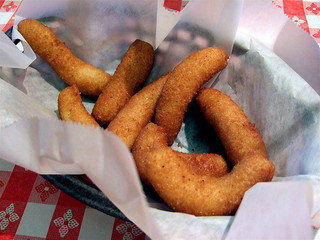 Consider, for a moment, the humble hushpuppy.
Consider, for a moment, the humble hushpuppy.
As with any deceptively simple Southern food, the hushpuppy should be easy to make. The creation of a hushpuppy should be as easy as cornmeal and cast iron to fry it in. As any person who belongs in a Southern kitchen will tell you, however, there’s a great deal more that goes into the crunchy, fluffy, savory bite of fried cornbread that tells you the sort of meal you’re in for.
There’s no shortage of legends surrounding the creation of this iconic Southern food, but the story of the hushpuppy does not begin with Confederate soldiers avoiding an ambush or Underground Railroad operators slipping through dragnets – with either (or both) using balls of fried cornbread dough to hush up any puppies that might have stood in the way.
Instead, one of the more probable origin points of the term “hushpuppies” seem to originate in the practice of tossing scraps from fish fry plates to family dogs during and after the meal. The fried dough in question – a mixture of cornmeal, sugar and egg – was fried in the fish grease and lard used to prepare the main course, serving as an effective and economical side dish.
Romeo Govan, who was born into slavery and settled in South Carolina after the Civil War, was specifically noted as an expert in the art of frying fish and Southern cooking. Govan hosted family dinners and fish frys that attracted folks from miles around, and from the money he made selling food he bought his own home and acres of land around it. Govan’s fried fish – and the “redhorse bread” that accompanied it – were notable enough to land him a review in the Augusta Chronicle in 1903 .
(note: the name “redhorse bread” comes from a specific species of river-dwelling fish)
The popularity of the hushpuppy skyrocketed in the early 1900s. Recipes were printed in newspapers, Boy’s Life magazine local cookbooks and elsewhere – but the final word came from North Carolina.
Though a hushpuppy by another other name would surely taste as sweet, the reason that we know and love that particular moniker – and don’t eat our Calabash shrimp with “three-finger bread” or “wampus” – comes from an entrepreneur in a small town on the NC coast.
In 1948, a man named Walter Thompson began selling pre-mixed bags of cornmeal, flour and seasoning. His business was based in Swansboro, North Carolina, a business that he named “The Hushpuppy Corporation of America” as he began to sell “Thompson’s Fireside Hushpuppy Mix.” The boxes bore labels promising “a delightfully different Southern hot bread,” and all the average cook had to do was add a bit of water to produce it. The business attracted investors, moved to Jacksonville and kept selling the same mix until it was purchased by House-Autry Mills – another North Carolina baking-aisle business from whom you can buy that same hushpuppy mix today.
 Tall tales and homegrown myth have a way of simultaneously enhancing and cheapening the experience – like Velveeta mac n’ cheese at a family reunion. Similar to a great deal of American lore, the beginning of the hushpuppy truly came from Native Americans, as they were cultivating and cooking corn long before any of us even thought away new and exciting ways to fry food.
Tall tales and homegrown myth have a way of simultaneously enhancing and cheapening the experience – like Velveeta mac n’ cheese at a family reunion. Similar to a great deal of American lore, the beginning of the hushpuppy truly came from Native Americans, as they were cultivating and cooking corn long before any of us even thought away new and exciting ways to fry food.
The legacy of cooking in the South is often one of hardship, of making the most out of what we had at the time. To dilute the creativity and skill that led to frying modified cornbread dough in fish grease is to dilute what makes this sort of food special – even as it remains as delicious and essential a side dish as it was over a century ago.
Itching to make your own hushpuppies? It’s likely easier than you think, and you’ve most likely already got the ingredients at home. Be advised: everyone has their own hushpuppy recipe, from Duke’s Mayonnaise to the James Beard Foundation. You can also find a video-format recipe here, courtesy of a certain famous YouTube cooking personality.
The crux of making hushpuppies is combining cornmeal, flour, milk and ideally an egg or two. Check the above recipes – or seek out your own variation – to find the ideal hushpuppy for you and yours. In the meantime, here are a couple hushpuppy protips to make sure that the first batch out of your fryer meet all your expectations:
- Oil Temperature. You’re looking for a temperature of around 375°F. If you don’t have a kitchen thermometer, there’s no time like the present to acquire one.
- Fry with peanut oil. High smoke point, good flavor. There’s a reason this is used in fast food joints, these days.
- Cast iron isn’t a requirement, just a strong suggestion.
- Make sure to flip your hushpuppies. A hushpuppy cooked on one side is sad.
- Don’t overmix! You’re not making bread, you’re making loose balls of dough. All the fluff in a hushpuppy comes from a distinct lack of mixing, so hands off one the ingredients are thoroughly combined.
- Sweet cornbread is a Northern abomination, but a pinch of sugar in the hushpuppy batter/dough will be wonders for browning – as will a bit of baking powder.

